How To Create A Library In C++
C++ Tutorial - Libraries - 2020
![]()
![]()
bogotobogo.com site search:
Static vs Dynamic Libraries
Use dynamic libraries instead of static libraries whenever possible!
There are two types of libraries we can make. The decision on which one we take can have a significant impact on our clients' applications, such as executable size, load time, etc.
Static Libraries
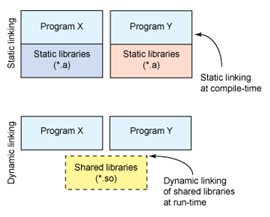
A static library contains object code linked with an end-user application, and then becomes part of that executable. A static library is sometimes called an archive since it is just a package of compiled object files. These libraries are in directories such as /lib, /usr/lib or /usr/local/lib.
After resolving the various function references from the main program to the modules in the static library, a linker extracts copies of the required object modules from the library and copies these into the resulting executable file. When linking is done during the creation of an executable, it is known as static linking or early binding. In this case, the linking is usually done by a linker, but may also be done by the compiler. A static library, also known as an archive, is intended to be statically linked. Originally, only static libraries existed. Static linking must be performed when any modules are recompiled.
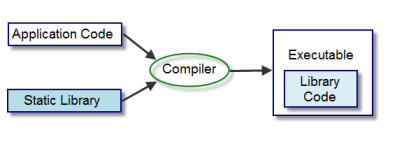
All of the modules required by a program are sometimes statically linked and copied into the executable file. This process, and the resulting stand-alone file, is known as a static build of the program.
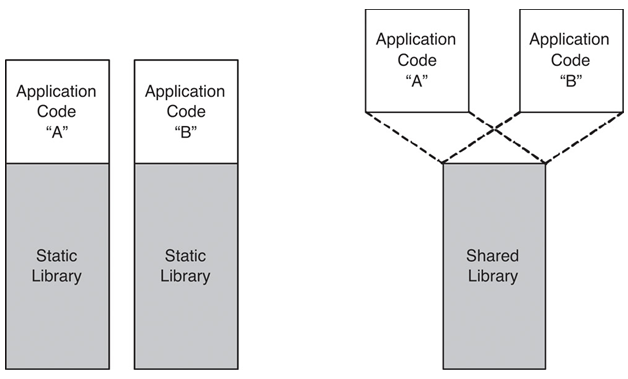
The filenames always start with lib, and end with .a (archive, static library) on Unix/Linux, and on Windows it's a little bit complicated. Depending on how they are compiled, *.LIB files can be either static libraries or representations of dynamically linkable libraries needed only during compilation, known as Import Libraries. Unlike in the UNIX world, where different file extensions are used, when linking against *.LIB file in Windows one must first know if it is a regular static library or an import library. In the latter case, a .DLL file must be present at run time.
Here are implications of distributing our implementation as a static library:
- A static library is only needed to link an application. It is not needed to run that application because the library code is already embedded inside the application. So, our clients can distribute their applications without any additional run-time dependencies.
- If our clients want to link our library into multiple executables, each one will embed a copy of our code. If our library is 100MB in size, and our client wishes to link this into three separate programs, then we could be adding up to 300MB to the total size of their product. Notice that only the object files in the static library that are actually used are copied to the application. Thus, in reality, the total size of each application could be less than this worst case.
- Our clients can distribute their applications without any concerns that it will find an incompatible library on the end-user's side or a completely different library with the same name from another vendor.
- But if our clients want to be able to hot patch their application, in other words, they want to update the version of our library used by their application, they must replace the entire executable to achieve this. If this is done as an internet-based update, the end user may have to download a much larger update and hence wait longer for the update to complete.
Dynamic Libraries
A shared library or shared object is a file that is intended to be shared by executable files and further shared objects files. Modules used by a program are loaded from individual shared objects into memory at load time or run time, rather than being copied by a linker when it creates a single monolithic executable file for the program.
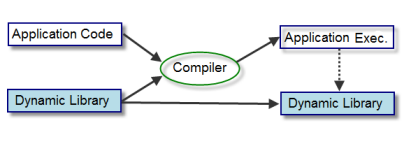
In other words, dynamic libraries are files linked against at compile time to resolve undefined references and then distributed with the end-user application so that the application can load the library code at run time. Usually, this requires use of a dynamic linker on the end user's machine to determine and load all dynamic library dependencies at run time, perform the necessary symbol relocations, and then pass control to the application.
The Linux dynamic linker is called ld.so and on the Mac it is called dyld. The dynamic linker supports a number of environment variables to modify or debug its behavior.
As mentioned earlier, dynamic libraries are sometimes called shared libraries because they can be shared by multiple programs. On Unix-like machine, they have a .so (shared object, dynamically linked library) file extension. On Windows, dynamically linkable libraries usually have the suffix *.DLL, although other file name extensions may be used for specific purpose dynamically-linked libraries, e.g. *.OCX for OLE libraries.
Here are implications of using dynamic libraries to distribute our program:
- Our clients must distribute our dynamic library with their application as well as any dynamic libraries that our library depends on, so that it can be discovered when the application is run.
- Our clients' applications will nor run if the dynamic library cannot be found. Also, the application may not run if the dynamic library is upgraded.
- Using dynamic libraries can often more efficient than static libraries in terms of disk space if more than one application needs to use the library. This is because the library code is stored in a single shared file and not duplicated inside each executable. However, even with static library, the executable only needs to include the object code from the static library that is actually used. So, if each application uses only a small fraction of the total static library, the disk space efficiency can still rival that of a single complete dynamic library.
- Dynamic libraries may also be more efficient in terms of memory. Most modern OS will attempt to only load the dynamic library code into memory once, and share it across all applications that depend upon it. This may also lead to better cache utilization. By comparison, every application that is linked against a static library will load duplicate copies of the library code into memory.
- If our clients want to hot patch their application with a new (backward compatible) version of our shared library, they can simply drop in the replacement library file and all of their applications will use this new library without having to recompile or relink.
Plugins
Plug-ins enable customizing the functionality of an application. For example, plug-ins are commonly used in web browsers to play video, scan for viruses, and display new file types. Well-known plug-ins examples include Adobe Flash Player, QuickTime, and Microsoft Silverlight.
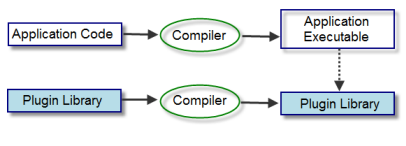
Dynamic libraries are usually linked against an application and then distributed with that application so that the OS can load the library when the application is launched. However, it is also possible for an application to load a dynamic library on demand without the application having been compiled and linked against that library.
This can be used to create plugin interface, when the application can load additional code at run time that extends the basic capabilities of the program.
This gives us the capability to create extensible code that allow our clients to drop in new functionality that our program will then load and execute.

Building Library
Here are sample codes:
// mylib.h #ifndef MYLIB_H #define MYLIB_H double calcSqrt(double);

0 Response to "How To Create A Library In C++"
Post a Comment